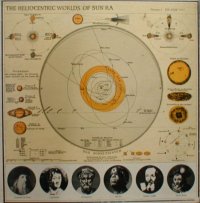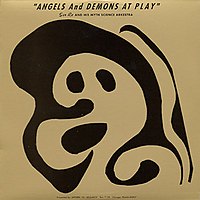
To become a god, you must destroy your own past. But history is no longer so easy to destroy, so perhaps it might be re-invented.
There's little doubt that much significance is bound in Sun Ra's 'Magic City' release from '65, given the reference to Birmingham. There's certainly little neutrality in the title, and the album is probably Sun Ra's most complex and ferocious. Can we wonder whether Sun Ra, then 50, might have looked back at his home town in a strange(r) light? If The Magic City does not describe Birmingham, might it instead describe the echo in Ra's mind that had made him whatever it was he had become?
I'm taking the view here that The Magic City (recorded between Heliocentric Worlds vol. 1 & 2) represents the peak of Ra's creative talent as composer and leader. Of course it is likely that Ra's methods at both were probably highly unorthodox, but The Magic City stands as one of the most challenging pieces of 20th century music; not simply jazz, but across all genres. It is at once clearly informed by modes within modern classical music, electronic, avant-garde, and free-blowing atonal jazz.
The title track, which may be more significant than the other tracks, spans nearly 30 minutes and both begins and ends with an apparent melody on Clavioline. From here, the Solar Arkestra expands, expands, and then expands again to explore pretty much everything within the range of the band. Light atmospheres combining keyboard and reeds. This first segment is utterly alien and sounds like a science fiction soundtrack. Gradually this becomes more and more demanding as the atonal horns come into play with attacks no less aggressive (possibly more so) than Heliocentric Worlds. Percussion comes into play and Ra shifts to piano. Rhythmically this is similar to Cosmic Tones in some ways, but the former is much more approachable.
Obviously across such length there is room for solos, but ultimately the full force of the entire Arkestra comes rolling in, and at this late point in the track, it is like listening to several pieces simultaneously. Lines which might be melody (it is hard to say) progress very quickly, almost as though someone is holding down the fast forward button, and we might say the piece has become 'hyper-dense'.
It winds down (as said before), with a keyboard / piano melody, but then there is a final blast of horns (again, shades of Helocentric Worlds). When all is said and done, this is no less than Kraanerg or Hymnen or other legendary pieces of experimental music. It no more belongs to jazz than any genre and it remains hard to understand where this music (early to mid 60's) came from.
Of the remaining tracks, 'Abstract Eye' and 'Abstract "I"' are both short and feel more like outtakes rather than major works. 'The Shadow World' however is quite the opposite. We have encountered this title before on the ESP 'Featuring Pharaoh Sanders' release, but here we can examine it with 'studio fidelity'...or at least, better fidelity than offered by the previous live recording. With careful listens, one may be surprised to discover that the track is in fact melodic, even if it doesn't sound that way at first. Listen to it casually and you'll hear a lot of low end percussion (perhaps strings) and some occasional outbursts of horns. The track heats up, gets loud for a while, and then it's over. Pretty much what we've come to expect from Heliocentric Worlds 1 & 2, but in this case we'd be wrong.
I've been spinning these discs off and on now (magic city, heliocentric worlds 1 & 2) for a few months, and although it may be that I've missed the subtlety elsewhere (not unlikely), I think I've only first started noticing the subtle melody in 'Shadow World' very, very recently. It is at first played by the percussion and what might be strings, and only after the track is been going well over a minute. Because it is being played so low, it is very likely you'll need to turn up the sound to make it out. What sounds purely like rhythm is not just rhythm but is a tiny melodic rift. Of course, this is Sun Ra melody we are talking about here, so it isn't just unusual that it is being played at the lowest possible register, and percussively nonetheless, but also is the sort many may not even call melody.
Since you've waited so long for this blog entry, I'll risk taking a tangent from not just Sun Ra but jazz as a whole and discuss metal. I probably know even less about metal than jazz, but having a friend with great expertise in the genre helped me understand a few things going on in the more difficult areas of metal--in particular, death metal. Like jazz, metal evolved to a point where many fans became alienated because they could no longer find the melody. They didn't know what to listen for. Death Metal for instance tends to use very short riffs, often played very fast, sometimes seemingly more rhythmic in nature than 'melodic', but these still in fact make up the melody. Until you hear these, death metal may just sound like some kids making guttural sounds flailing on their guitars, but once you start to hear the music....
...well, the same is true I think with a lot of Sun Ra. Melodies are often both subtle and bizarre. With 'The Shadow World', we have a melodic track that disguises its own melody. Certainly after 'The Magic City', you may have given up trying to find the melody, but yes, it is there...somewhere.
We are almost out of the woods with the 'heavy' albums. I don't know if that is good or not, since after Strange Strings, we see Sun Ra moving closer and closer to more accessible music, but we're still a decade away from playing on Saturday Night Live, so there's still a lot of strange music to come.


























